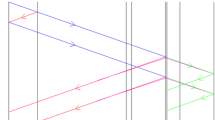Abstract
The reason for the observation of an anomalously long pulse duration time of a signal transmitted from a soft specimen in a Kolsky bar experiment is investigated. A systematic numerical experiment based on explicit finite element analysis has been carried out using elastic specimens with varying elastic moduli. The soft specimen is in a compressive state even after the passage of the pulse because it cannot push the bars, such that a fairly long transmitted pulse is monitored at the gage position of the output bar. The arrival of the second pulse (tensile) from the right-end surface of the output bar releases the first transmitted signal (compressive) coming from the compressed state of the specimen, which puts an end to the fairly long transmitted pulse. Because the observation of a prolonged transmitted pulse is a natural phenomenon, the prolonged transmitted pulse should not annoy researchers in the process of confirming the validity of experiments on soft specimens. Our concern in verifying the validity of experiments can be limited to other aspects such as the process of measurement and the amplification of weak transmitted signals coming from soft specimens.
Similar content being viewed by others
References
Lee, T. H., “Development of a Theoretical Model to Predict Cutting Forces for Hard Machining,” Int. J. Precis. Eng. Manuf., Vol. 12, No. 5, pp. 775–782, 2011.
Ahn, T.-K. and Kim, K. W., “Semi-Empirical Method to Estimate Dynamic Stiffness of Pre-Deformed Elastomers,” Int. J. Precis. Eng. Manuf., Vol. 13, No. 12, pp. 2259–2262, 2012.
Cho, J.-U., Kinloch, A., Blackman, B., Rodriguez, S., Cho, C.-D., and Lee, S.-K., “Fracture Behaviour of Adhesively-Bonded Composite Materials under Impact Loading,” Int. J. Precis. Eng. Manuf., Vol. 11, No. 1, pp. 89–95, 2010.
Kolsky, H., “An Investigation of the Mechanical Properties of Materials at Very High Rates of Loading,” Proceedings of the Physical Society, Section B, Vol. 62, No. 11, pp. 676, 1949.
Shin, H. and Kim, J.-B., “Correction Functions to Determine the Stress State of a Flattened Disk Specimen in Diametral Testing with Reference to Analytical Solutions for Circular Specimens,” Int. J. Precis. Eng. Manuf., Vol. 16, No. 13, pp. 2699–2707, 2015.
Hughes, F., Prudom, A., and Swallowe, G., “The High Strain-Rate Behaviour of Three Molecular Weights of Polyethylene Examined with a Magnesium Alloy Split-Hopkinson Pressure Bar,” Polymer Testing, Vol. 32, No. 5, pp. 827–834, 2013.
Yang, I. Y., Jeong, J. Y., and Kim, J. H., “Fracture Toughness of CFRP Laminated Plates according to Resin Content,” Int. J. Precis. Eng. Manuf., Vol. 11, No. 2, pp. 309–313, 2010.
Shergold, O. A., Fleck, N. A., and Radford, D., “The Uniaxial Stress Versus Strain Response of Pig Skin and Silicone Rubber at Low and High Strain Rates,” International Journal of Impact Engineering, Vol. 32, No. 9, pp. 1384–1402, 2006.
Chen, W., Lu, F., Frew, D. J., and Forrestal, M. J., “Dynamic Compression Testing of Soft Materials,” Journal of Applied Mechanics, Vol. 69, No. 3, pp. 214–223, 2002.
Ouellet, S., Cronin, D., and Worswick, M., “Compressive Response of Polymeric Foams Under Quasi-Static, Medium and High Strain Rate Conditions,” Polymer Testing, Vol. 25, No. 6, pp. 731–743, 2006.
Bryson, J. A., “Impact Response of Polyurethane,” M.Sc. Thesis, School of Mechanical and Materials Engineering, Washington State University, 2009.
Nemat-Nasser, S., Isaacs, J. B., and Starrett, J. E., “Hopkinson Techniques for Dynamic Recovery Experiments,” Proceedings of the Royal Society of London A: Mathematical, Physical and Engineering Sciences, Vol. 435, pp. 371–391, 1991.
Yang, R., Zhang, H., Shen, L., Xu, Y., Bai, Y., and Dodd, B., “A Modified Split Hopkinson Torsional bar System for Correlated Study of t Relations, Shear Localization and Microstructural Evolution,” Philosophical Transactions of the Royal Society of London A: Mathematical, Physical and Engineering Sciences, Vol. 372, DOI NO.10.1098/rsta.2013.0208, 2014.
Shin, H., Lee, H., Kim, J. B., and Yoo, Y. H., “A Numerical Verification of the Reliability of a Split Hopkinson Pressure Bar with a Total Bar Length of 3m and a Diameter of 1 Inch,” Applied Mechanics and Materials, Vols. 799-800, pp. 681–684, 2015.
Ogden, R. W., “Large Deformation Isotropic Elasticity-on the Correlation of Theory and Experiment for Incompressible Rubberlike Solids,” Proceedings of the Royal Society of London A: Mathematical, Physical and Engineering Sciences, Vol. 326, No. 1567, pp. 565–584, 1972.
Dassault Systèmes, “Abaqus 6.13 Documentation,” http://129.97.46. 200:2080/v6.13/ (Accessed 5 JAN 2016)
Author information
Authors and Affiliations
Corresponding authors
Rights and permissions
About this article
Cite this article
Shin, H., Kim, JB. Understanding the anomalously long duration time of the transmitted pulse from a soft specimen in a kolsky bar experiment. Int. J. Precis. Eng. Manuf. 17, 203–208 (2016). https://doi.org/10.1007/s12541-016-0026-8
Received:
Revised:
Accepted:
Published:
Issue Date:
DOI: https://doi.org/10.1007/s12541-016-0026-8




